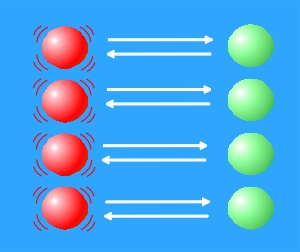
Think of a petit-mal seizure as something like
two teams of jugglers, each reflecting the
activity of one group of cells in the brain.
These two teams are standing in two lines each
facing the opposite team, and they are all
juggling in unison. I.e. the members of the
green team all release pins at the same time,
and the red team all catch pins at the same
time.
This is something like a petit mal attack, where the brain becomes involved in an internal juggling match. This juggling takes up so much concentration that during an attack children with this form of epilepsy blank out and ignore the outside world. Then suddenly the seizure stops and they come back into consciousness.
Normally our brains prevent this sort of juggling in unison (synchrony) through activation of certain neural pathways. In our analogy those pathways are like the members of the red juggling team, and their interactions amongst themselves. When the pathway is intact and fully functional the red team members move around a bit during their act and thus interfere with each other, perhaps by needing elbow room. Now when one member is juggling he throws out his elbows so that his two neighbors wont be able to juggle in unison with him/her. The neighbors can probably still throw and catch, but a little bit before or after the first team member. In this case individual pairs of jugglers (one each from the green and red teams) can juggle just fine, as long as they are not trying to match the pace of the whole team -- hence less synchrony is the result when members from one team interfere with each other.
This is what the inhibitory connections between RTN (red) cells do - they prevent synchrony in the thalamic network.